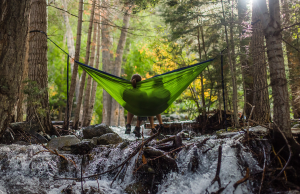
- The positive effects of nature on mental and physical health are well-documented.
- Captain Obvious says that’s because humans evolved outdoors, not indoors, for 99.9% of their time on Earth.
- Virtual reality nature lacks the multisensory inputs (like soil, volatile organic compounds, and soundscapes) that people need to get the full health benefits of the environment.
- Nature deficit disorder can be caused by anxiety, overparenting, and poor urban planning.
- Nature-based therapy, aka ecotherapy, and forest medicine are ways of enhancing one’s relationship with the restorative outdoors.
You’ve probably heard about forest medicine, how spending time in the woods can lower your stress levels, improve your mood, bolster your immune system, and perhaps literally recharge your body (when you’re barefoot). It all seems so obvious, considering that homo sapiens evolved in tandem with their ecosystem. But if medicalizing a human’s natural state encourages people to recreate who they were for 99.99% of their history on earth, then by all means let’s put prescription labels on trees.

Nature Therapy Engages All Senses
The Japanese scientists who pioneered the discipline of forest medicine say that to get the full physical and mental health benefits, you have to engage all your senses: sight, sound, touch, taste, and smell. Some shinrin-yoku (forest bathing) advocates add a sixth sense: a forest state of mind. You can call this the feeling of awe and wonder. Joy. Peace. The sublime. Spiritual engagement. Deep flow. Transcendence. It’s not exactly quantifiable, but it can contribute to the immersive, forest bathing experience.
This sixth sense might be part of the reason why virtual nature or nature 2.0 doesn’t seem to grant the same restorative health benefits that natural nature gives us free of charge. [Sidebar: modern life is so disconnected from our primordial Mother Earth that I have to distinguish here between natural nature and artificial, virtual reality (VR) nature.] It’s much harder to recreate the multisensory ecotherapy experience in a lab because that might require the following elements:
- Mycobacterium vaccae. This common bacteria found in soil can promote stress resilience. Mammals evolved with their interdependent, microbial “old friends” for millions of years with consequences for behavior, emotion, and overall health. Disconnection from nature can affect our guts and our neurochemistry.
- Phytoncides. Phytoncides (the word means “exterminated by the plant”) are aromatic volatile substances–better known as smells–produced by plants as a natural defense against bacteria, fungi, and insects. When inhaled by humans, these antimicrobial oils can reduce stress, lower blood pressure, and boost immunity.
- Electrical currents. Human bodies naturally conduct electricity. There’s some intriguing evidence that direct skin contact with the earth (called earthing or grounding) can reduce inflammation, mitigate pain, and improve sleep due to the free flow of electrons from planet to body.
- Negative air ions. Plants, sunlight, and moving water can generate negative air ions that may have positive biological effects on humans, including improvements in mood.
- Soundscapes. Acoustic information like birdsong or a tinkling stream can provide humans with vital information about their environment, which is probably why we respond so positively to natural sounds.
- Air quality. Air pollution can contribute to numerous human health problems, including psychiatric disorders. Indoor air pollutants can be up to 5 times higher than outdoor concentrations. Trees, our great protectors, tackle gaseous air pollution through their leaves.
- Biophilia. The evolutionary biologist Edward O. Wilson thought that all people have an innate love for nature, called biophilia. This cognitive appreciation might be absent if people aren’t in “real” nature. One study that compared the experiences of people in a natural environment versus those in an indoor simulation showed that while both groups experienced stress reduction, only the group in the natural environment felt increased energy and “altered states of consciousness.”
- Soft fascination. Some researchers believe that nature allows the human brain to engage in soft fascination, which requires less mental bandwidth than, say, watching television, which is considered hardly fascinating. In Attention Restoration Theory (ART), soft fascination allows for mental reflection and restoration. It’s different from rumination, which is associated with depression. In fact, in one study, a 90-minute walk in nature reduced both rumination and neural activity in the subgenual prefrontal cortex (sgPFC), an area of the brain associated with mental health conditions. A 90-minute walk in an urban setting had no effect on either metric.
People can reap some health benefits from artificial green environments—anything is better than nothing—but they don’t receive the full dose of mental relaxation and preventive medicine through VR goggles. So why doesn’t everyone just open their front door and go outside? Because to enjoy all the sweeping physical and mental health benefits of nature, you need to feel safe.
There’s a theory in environmental psychology that humans evolved to feel awe when confronted with beautiful, natural vistas because they represent safety and shelter. You can see your enemies coming from miles away. The Grand Canyon is so glorious partly because predators aren’t going to get you there. But today we have invisible predators like climate change and Covid-19. Feeling safe outdoors can be a tall order.
What Keeps Us Indoors and De-Natured
Average Americans spend 90% of their time indoors. Richard Louv coined the term “nature deficit disorder” to describe this modern condition that he thought needed pathologizing. And it does seem to be a sickness. Disconnection from nature has been blamed for increased attention difficulties, more depression and anxiety, higher cancer rates, and more. Tragically, Louv called “the child in nature” an endangered species. In his book “Last Child in the Woods: Saving Our Children from Nature-Deficit Disorder,” he wrote of “de-natured” children who didn’t know how to play in the forest.
From the dawn of agriculture, humans have been trying to get inside. Now the following factors make it difficult to get outdoors:
- Cities. Poor urban planning can lead to people in cities having less access to natural settings, more exposure to heat islands, and massive green inequality in wealthy versus impoverished areas.
- Crime. People may worry about being vulnerable to violence when they’re alone in the wilderness. Someone venturing out in the city might fear crime or, in the case of children, local bullies.
- Covid-19. The pandemic has caused more people to stay inside.
- Extreme temperatures. Global warming has led to more inhospitable temperatures and extreme weather events.
- Anxiety and depression. These mental health conditions can lead to self-isolation at home. Ironically, people with anxiety and depression may be the ones who can benefit most from nature.
- Fewer green and blue spaces. The happiness of a population might depend on its proximity to green and blue spaces, and yet those oases are disappearing with every new shopping center. By the way, blue spaces might be even more restorative than green spaces (sorry, forest doctors!).
- Adult supervision. Anxious parents may inadvertently hinder their kids’ spontaneous play by overstructuring and oversupervising. Kids need to feel free to create their own meaning in nature.
- Screens. Our addictive digital screens tend to monopolize our time and attention.
- Lack of education. Many people don’t learn about nature’s critical importance to human well-being.
- Air pollution. People with allergies or people in areas prone to wildfire may avoid the outdoors.
- Noise pollution. People who experience sensory overload may find soundscape ecology overwhelming, especially in urban areas. Noise pollutants like air traffic can diminish their positive experience.
Angela Basso, a Licensed Mental Health Counselor at Thriveworks in Tampa, says, “Nature therapy has become more popular on the back of the pandemic, which saw an increase in mental health issues.” Starting in 2020, many people “developed a fear of going outside.” Basso says that some therapists encourage spending time in natural environments as part of a holistic approach to treatment. Walking in the forest. Meditating in the park. “There is a part of being human that is so connected to nature that we’re just drawn there.”
Concrete Advice for Escaping the Concrete Jungle
If you think of time in nature in terms of medicine, then you obviously need to consider exposure and dosage. After all, nature is a potent drug. Even low doses of nature can help prevent stress. Here are some tips for getting into the forest state of mind:
- You don’t necessarily have to walk, bike, or paddle. You can just sit passively to get the benefits.
- If you don’t like the wilderness, spending time in landscaped areas also works. Try visiting a botanical garden for a more manicured exposure to nature.
- You don’t have to love it. You’ll get the benefits even if you dislike the experience. But your attitude might affect dosage requirements.
- Get a houseplant.
- When indoors, sit by the window for some therapeutic gazing.
- Try aromatherapy with essential oils, especially scents of an evergreen forest.
- Seek out bodies of water. To your ancestral brain, blue might mean survival.
- Picnic in a park. Bonus points if you get dirt under your nails before you eat (yummy, yummy Mycobacterium vaccae).
- When you vacation, choose natural areas.
- Take off your shoes. Maybe the science seems a little New Age, but going barefoot feels good whether it has medicinal benefits or not.
- If you’re walking in the city, steer toward tree-lined streets (urban forest therapy).
- Eat your vegetables. That’s a natural experience as well.
- Cultivate a garden.
- Don’t helicopter-parent your kids. Let children be part of the natural world rather than inflicting nature on them.
- Turn outdoor chores into mindful nature experiences. For example, engage your five senses when you shovel snow or rake leaves.
And if it doesn’t feel too “woo-woo”, try to summon your awesome sixth sense when you’re basking in nature. What are these powers in the trees? Dr. Qing Li, the Japanese author of “Forest Bathing: How Trees Can Help You Find Health and Happiness,” writes: “For Zen Buddhists, scripture is written in the landscape. In Shinto, the spirits are not separate from nature, they are in it. They are in the trees, in the rocks, in the breeze, the stream, the waterfall….It is not unusual in Japan to find people worshipping in the forest.”













